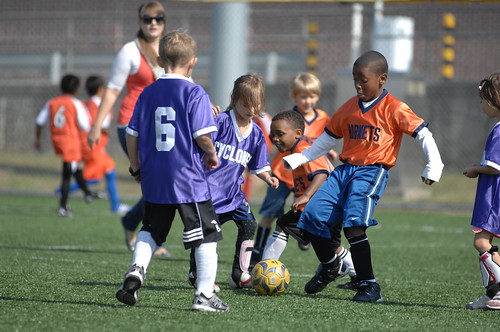Children may not complain of pain because they don’t want to labled as a whimp or may believe they will be dropped from the team either by the coach or their parent if they complain.
It is important that young people including young adults understand the danger in ignoring pain. Many times specialized exercises, massage therapy and interferential treatment can provide a safe method to relieve pain and prevent permanent damage.
Childhood sports injuries may be inevitable, but there are some things you can do to help prevent them.
Preventing Youth Sports Injuries
 Enroll your child in organized sports through schools, community clubs, and recreation areas where there may be adults who are certified athletic trainers (ATC). An ATC is also trained in the prevention, recognition and immediate care of athletic injuries.
Enroll your child in organized sports through schools, community clubs, and recreation areas where there may be adults who are certified athletic trainers (ATC). An ATC is also trained in the prevention, recognition and immediate care of athletic injuries.- Review the Parent’s Checklist for Spring Sports to help ensure a safe and healthy playing environment for their children who participate in organized sports.
- Make sure your child uses the proper protective gear, such as mouth guards or eye protection for a particular sport. This may lessen the chances of being injured.
- Warm up Before Exercise. This can help minimize the chance of muscle strain or other soft tissue injury during sports. Warm up exercises make the body’s tissues warmer and more flexible.
- Wear sunscreen and a hat (where possible) to reduce the chance of sunburn, which is actually an injury to the skin.
- Stay properly hydrated while playing.
- Know the warning signs of a serious injury
- Treat Injuries with R.I.C.E.
Rest. Reduce or stop using the injured area for 48 hours. If you have a leg injury, you may need to stay off of it completely.
Ice. Put an ice pack on the injured area for 20 minutes at a time, 4 to 8 times per day. Use a cold pack, ice bag, or a plastic bag filled with crushed ice that has been wrapped in a towel.
Compression. Compression of an injured ankle, knee, or wrist may help reduce the swelling. These include bandages such as elastic wraps, special boots, air casts and splints. Ask your doctor which one is best.
Elevation. Keep the injured area elevated above the level of the heart. Use a pillow to help elevate an injured limb.
Stay tuned for Common Childhood Sports Injuries Blog tomorrow.

No comments:
Post a Comment